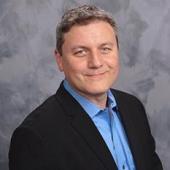3rd ACM International Conference on Nanoscale Computing and Communication
New York, USA, September 28-30, 2016
Holiday Inn L.I. City - Manhattan View
3rd ACM International Conference on Nanoscale Computing and Communication
New York, USA, September 28-30, 2016
Holiday Inn L.I. City - Manhattan View
Keynote Speakers
Plasmonic Devices for Terahertz Applications
 |
Michael Shur
Patricia W. and C. Sheldon Roberts Professor |
The field effect transistor (FET) feature sizes have shrunk to below 10 nm enabling the ballistic (collisionless) electron transport. At dimensions smaller than the electron mean free path for collisions with impurities or lattice vibrations, the transistor channel acts like a resonant cavity for the waves of the electron density (called plasma waves). The frequency of the plasma waves depends on the device dimension and electron density and might reach 10 THz in short channel devices. Nonlinearities of the electron transport cause the rectification of plasma waves inducing a constant voltage in response to a THz wave. Such nonlinearities are strongly enhanced in tunneling structures or structures with constricted channels. A DC electric current also increases the device nonlinearity and enhances the detection responsivity. It could also excite plasma waves leading to the THz generation. Several mechanisms for the plasma wave instabilities have been proposed and have been shown to be especially effective in periodic and grating gate structures. One such mechanism is a “plasmonic boom” when electrons cross from the regions where their drift velocity is smaller than the plasma wave velocity into the regions where their velocity is larger than the plasma velocity or vice versa. This effect is similar to a sonic boom experienced by supersonic jets. THz detectors have now found commercial applications. They are used for imaging and testing applications. Another application is in-situ non-destructive testing of transistor structures and VLSI, even under bias. The plasmonic FETs could also detect single picosecond and even subpicosend pulses. Applied bias voltages tune plasma wave detectors and sources and can modulate these devices at frequencies up to hundreds of gigahertz making them suitable for applications in wireless communications systems operating at 300 GHz and above.
Short Biography
Michael Shur was born on November 13, 1942 in Kamensk-Uralsky, Sverdlovsk, USSR. He received his master's degree in Electrical Engineering from St. Petersburg Electrotechnical Institute. In 1967 he received his PhD in physics from the A.F. Ioffe Institute in Petersburg, Russia.
Shur has held research or faculty positions at the A.F. Ioffe Institute, Wayne State University, Oakland University, Cornell University, IBM T.J. Watson Research Center, and the University of Minnesota. From 1989 to 1996, he was the John Money Professor at the University of Virginia, where he served as the director of the Applied Electrophysics Laboratories in 1996. He moved to Rensselaer Polytechnic Institute in 1996.
Noisy but Robust Information Communication by Living Cells
(Sponsored by CIRCLE)
 |
Andre Levchenko
John C. Malone Professor of Biomedical Engineering |
Living cells are miniature information-processing and decision-making machines. Frequently, they can self-organize into communities allowing complex functions, including higher cognitive capacities. However, cells store, precess and share information in a noisy environment, creating substantial uncertainty in the outcome of the signaling processes. In this talk I will survey the recent results, highlighting the nature of the noisiness, its effect on the ability of the cells to make pertinent decisions and various means used by the cells on the sub-micron scale to communicate and make robust decisions. These research advances pave the way for building hybrid devices, incorporating living matter and for developing new algorithms allowing robust function of human-made devices on the micro- and nano-scale.
Short Biography
Andre Levchenko was born in Russia and grew up in a small Siberian town. He obtained his B.S and first M.S Degrees at Moscow Institute of Physics and Technology. He then moved to the United States, getting his second M.S. and doctoral degrees at Columbia University, while also working at Memorial Sloan-Kettering Cancer Center. His subsequent post-doc at Caltech was focused on working with different labs on questions related to cell signaling in diverse areas spanning immunology, genetics, cell biology and computer science. He then spent 12 years working as faculty at Johns Hopkins University making various inroads into the experimental and theoretical analysis of information processing in live cells. In 2013, he was appointed the inaugural Director of Yale Systems Biology Institute and John C. Malone Professor of Biomedical Engineering at Yale. He has been at Yale every since. Andre received a number of awards and has been elected a Fellow of American Physical Society and of American Institute for Medical and Biological Engineering. Andre also is on Editorial Boards of several journals, including Science Signaling.